
Over the past few years, the one question that I’ve received the most is – What are the basic ingredients to get me started cooking real-deal Chinese food?
The short answer is, you only need 6 Chinese ingredients to get started cooking delicious Chinese food. These are the ingredients I use 80% of the time, if not every day.
I’ve also listed 3 must-have fresh ingredients, which you can often get at a grocery store.
The rest of the post contains 5 sauces and 5 spices that are commonly used in many of my recipes. It can come in handy, depending on the type of food you want to cook. For example, if you’d like to make authentic dim sum or Sichuan food.
After getting these basic Chinese ingredients, you’ll be able to cook a wide variety of Chinese dishes by combining them with other ingredients that you can find at the average grocery store.
NOTE: I have included a short introduction for each ingredient. If you want to read more about the ingredient, click on the title. It will lead you to a more thorough article on the use, storage, and shopping for that ingredient.
6 Must-Have Basic Chinese Ingredients
(1) Light soy sauce (or regular soy sauce)
Light soy sauce, or Sheng Chou (生抽), is a must-have Chinese ingredient. It’s saltier than regular soy sauce but has a lighter color. It adds a savory umami flavor to the dish without adding much color. Light soy sauce is commonly used in all kinds of dishes.
Note, “lite” soy sauce is a totally different thing, which is usually sold by Japanese brands. “Lite” soy sauce contains less sodium and has a different taste. It’s not suitable for Chinese recipes.
I usually keep a bottle of regular soy sauce on hand as well, which will add a bit of color to a dish. If you want to keep your pantry less crowded, you can keep either light soy sauce or regular soy sauce.
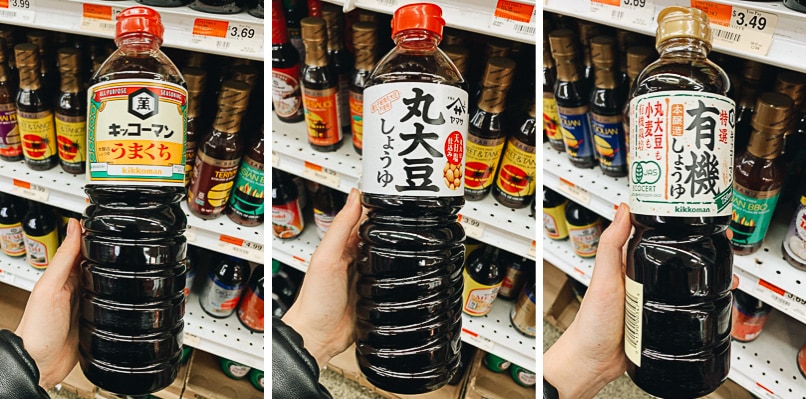
If you avoid gluten, you can either use tamari to replace the (light) soy sauce.
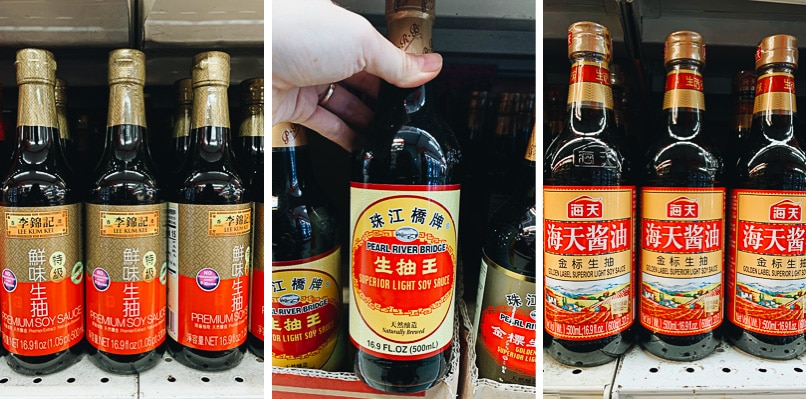
Recommended Brands
- Light soy sauce: Pearl River Bridge (my favorite), Lee Kum Kee, Haitian (Sometimes translated to Haday. My mom’s favorite brand)
- Regular soy sauce: Kikkoman (preferably made in Japan)
(2) Dark soy sauce
Dark soy sauce, or Lao Chou (老抽), tastes less salty and slightly sweet and is thicker in texture and darker in color. Dark soy sauce is more like a food coloring than a condiment. It is usually used together with light soy sauce in braising and sometimes stir frying, to add an appetizing dark brown color to a dish. It is responsible for the lovely deep color of dishes such as Beef Chow Fun and Red Braised Pork.
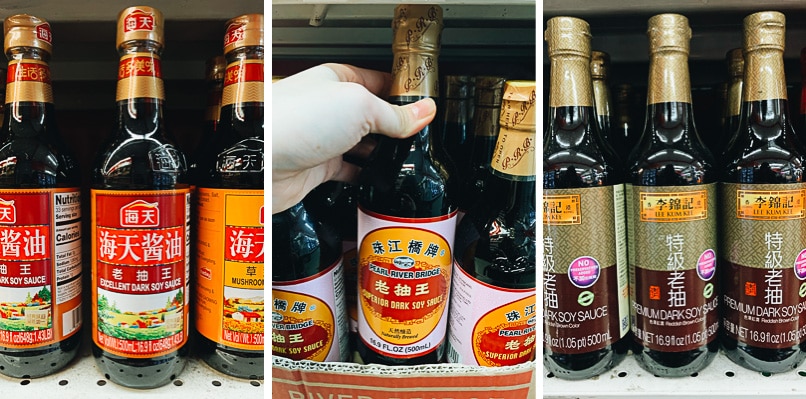
Recommended Brands
Pearl River Bridge, Lee Kum Kee, Haitian
(3) Chinkiang vinegar
Chinkiang vinegar, or Zhen Jiang Xiang Cu (镇江香醋), is sometimes called old vinegar (老醋, Lao Cu), or black vinegar (黑醋, Hei Cu). Chinkiang vinegar has a distinctive dark brown color that is almost like that of soy sauce. It has a rich, pungent, and tart flavor, with a fermented, malty taste and woody character that differentiates it from the lighter colored rice vinegar.
In China, Chinkiang vinegar is an important Chinese ingredient balsamic vinegar is in Italian cuisine. I use it to make General Tso’s Chicken, Hot and Sour Soup, and Cucumber Salad.
PS. On a different note, if you love northern Chinese cooking, also keep an eye on Shan Xi vinegar (sometimes called aged vinegar or mature vinegar). It has a more intense flavor and less sweet. It’s perfect for dumpling dipping.
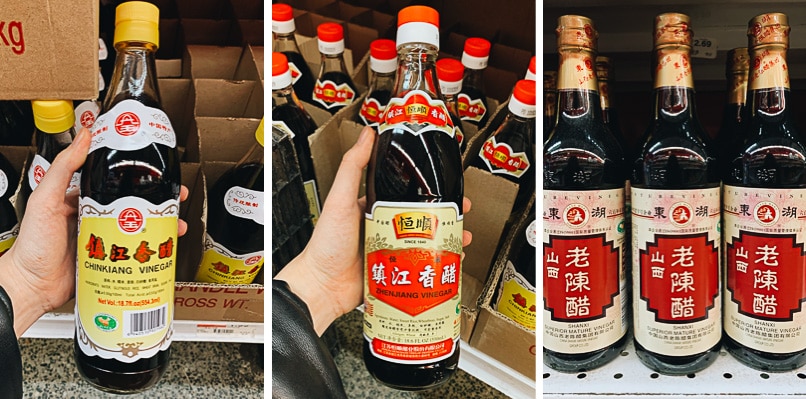
Recommended Brands
Golden Plum, Heng Shun, Shan Xi Vinegar (NOTE, the last one is not Chinking, but for dumpling dippings)
(4) Shaoxing wine (or dry sherry)
Shaoxing wine (绍兴酒, pronounced “shao-shing”) is a type of rice wine. It’s an important Chinese ingredient as soy sauce. It has a light brown color and a savory umami flavor that resembles light soy sauce. It adds depth of flavor to a dish and I use it in almost everything, from making sauce, to deglazing pans, and making marinade.
It has an alcohol content of around 17%, so it is impossible for grocery stores in some states to carry the original unsalted type. I highly recommend to purchase your Shaoxing wine from an Asian liquor store or Asian grocery store, where it is usually displayed in the liquor section (not the pantry section).
NOTE: Read the label before purchasing. I try to avoid the type that has salt in it, but if the salted one is the only type you can find, it’s OK to use them as well.
The next best thing to Shaoxing wine is dry sherry (avoid the sweet type), which you can get at most liquor stores.
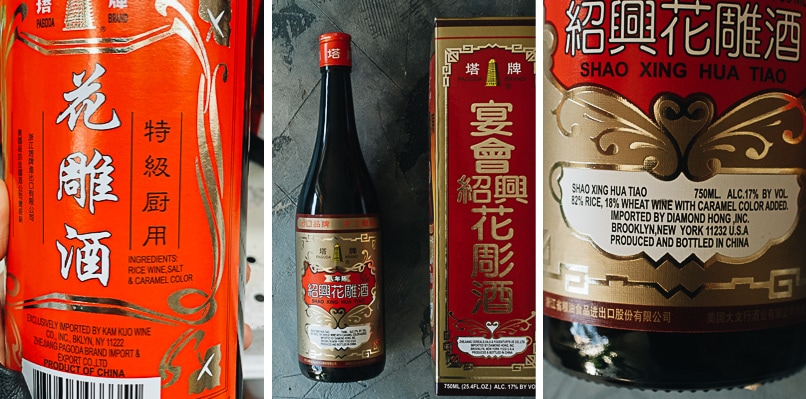
(5) Peanut oil
A great bottle of high-quality peanut oil will make all dishes instantly better. It has a high smoking point, which is perfect for stir-fries. Try to find an Asian brand that consists of 100% peanut oil. When you open the lid, the oil should be particularly fragrant and smell like peanut butter. It is as fragrant as toasted sesame oil, but with a higher smoke point and a much lower price (per volume, anyway). If you cook simple vegetable dishes, such as bok choy with hot garlic soy sauce or stir fried cabbage, you’ll notice a big difference when using pure peanut oil instead of regular vegetable oil. I often skip adding sesame oil in my dishes because I use the pure peanut oil.
You can usually find high quality peanut oil in an Asian grocery store. Note, it usually has a golden color, which is darker than that of the pale-colored regular peanut oil you see in regular grocery stores.
NOTE: read the label before purchasing. You should only purchase the one that contains 100% peanut oil. Some brands will produce both types – See the picture below. The one on the left says blended peanut oil in Chinese, and the product has a golden color. The one on the right is pure peanut oil and has a dark amber color.
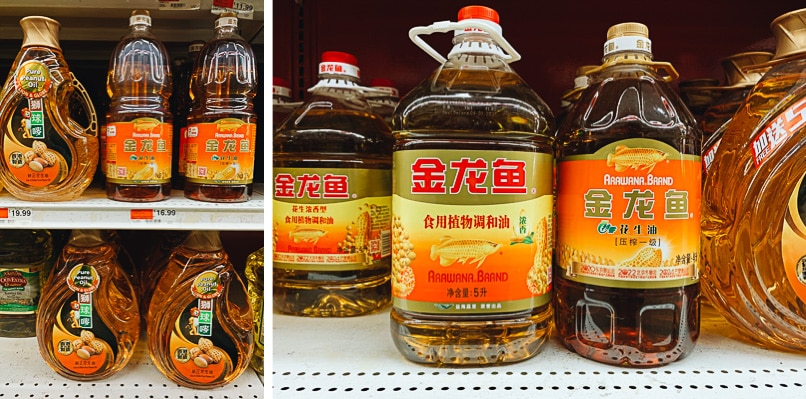
Recommended Brands
Lion & Globe (I love this brand it’s easier to find in the US), Arowana Brand (we use this in China)
(6) Cornstarch
Cornstarch is a very important part of any Asian pantry, because you will use it to thicken sauces and soups, marinate meat, and pan fry ingredients to create a crispy crust.
For example, you will use the cornstarch slurry to create the silky texture of egg drop soup. You will need it to create the sticky texture of sauces, such as orange sauce and General Tso’s sauce. In many recipes, I use cornstarch to coat meat and pan fry it, to create a super crispy deep-fried texture. Such as with the salt and pepper chicken.
It’s possible to use other starches, such as potato starch or tapioca starch, to replace the cornstarch. But each starch has a different thickening power. So you might need to adjust the amount used in my recipes.
3 Essential Fresh Ingredients – Aromatics
Ginger, Green Onion, and Garlic
I’ve seen cookbook authors call these the Holy Trinity of Chinese Cooking. It’s very true and I will forever have all three of them in my pantry. You will use them in most Chinese dishes. All three of them add aroma and fragrance to a dish. Although ginger has another advantage – it contains enzymes that can tenderize meat.
For stir-fried dishes, you will saute aromatics in oil to infuse the flavor of the aromatics, which creates a rich and robust sauce that tastes so much better than bottled sauce. Just look at how much of these aromatics I used in the Char Siu Chow Mein.
Aromatics are also commonly used in meat marinades, dumpling fillings, soups, and cold dishes. See how I repetitively used green onion and ginger in the Wonton Soup. And how I used all three of these aromatics and some Chinese sauces to turn poached chicken into a feast in my Bang Bang Chicken recipe (So many readers have told me it’s their favorite Game Day snack now).
You might be familiar with green onion and garlic, which are very common in a regular market. However, I do find that fresh ginger can be hard to find sometimes, depending on where you live. So I’ve created a post on How to Freeze Ginger, so you can store it for a long time. Sometimes you will also find packaged ginger paste that comes in a tube. It’s less fragrant than fresh ginger, but still works much better than dry ginger powder.
7 Nice-to-have Chinese Ingredients – Sauce & Paste
(1) Rice Vinegar
Rice vinegar is fruity and slightly sweet. Compared to Chinkiang vinegar, rice vinegar is less commonly used on a daily basis. However, if you like dishes such as Orange Chicken, Sweet and Sour Pork, and Honey Chicken, rice vinegar is a must. I also like to use it to make Pickled Cabbage.
Recommended Brands
Marukan (or other Japanese brands)
(2) Oyster sauce
Oyster sauce (蚝油, hao you) is a dark, thick sauce made from oyster extract. It is salty, savory, a bit seafoody, and lightly sweet. It adds umami and sweetness to a dish. Commonly used in Cantonese cuisine, it is a must-have ingredient for fried noodles and dim sum.
No matter whether you’re making a quick Chicken Chow Fun or Chicken and Broccoli, oyster sauce will add a rich taste to your dish. It’s also a key ingredient for making authentic egg rolls.
NOTE: Oyster sauce comes with different grades. The premium type (left in the picture) contains more oyster essence and has a better taste. The regular one (middle in the picture) contains more sugar and is cheaper.
For vegetarian and vegan dishes, you can use vegetarian oyster sauce or homemade vegetarian oyster sauce.

Recommended Brands
Lee Kum Kee (they invented oyster sauce), Chee Hou Sauce for vegetarian / vegan alternatives
(3) Hoisin sauce
Hoisin sauce (海鲜酱, hai xian jiang) is a dark, thick sauce made mostly from sugar and soybeans. It’s commonly used in Cantonese cuisine – a key ingredient for making Char Siu Pork and Char Siu Buns. It’s also a popular dipping sauce that is great for veggies and roasted meat.
Consider using my Homemade Hoisin Sauce recipe instead of purchasing it.
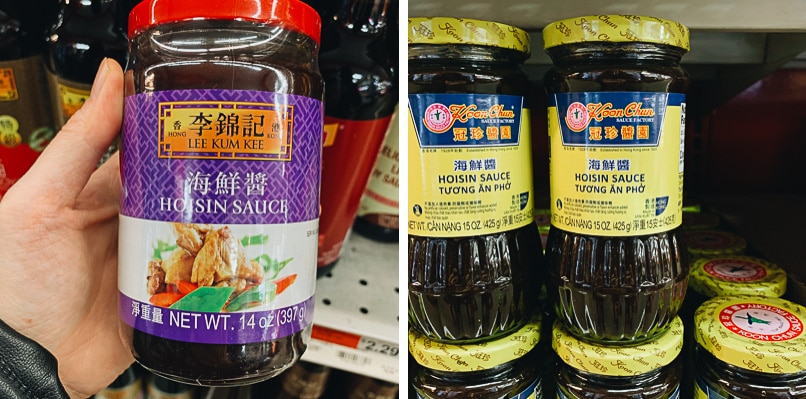
Recommended Brands
Lee Kum Kee, Koon Chun, Kikkoman
(4) Doubanjiang
Doubanjiang (豆瓣酱), or Chinese spicy fermented bean paste, is a thick dark brown paste that tastes salty, fermented-savory, and spicy. A key ingredient in Sichuan cuisine, you’ll need this one if you want to cook a good Mapo Tofu, Twice Cooked Pork, or Yu Xiang Eggplant. I also highly recommend this ingredient if you like spicy food, because it adds a rich taste to any simple stir fried dish immediately. For example, super simple yet delicious Green Beans with Ground Pork and Braised Daikon Radish.
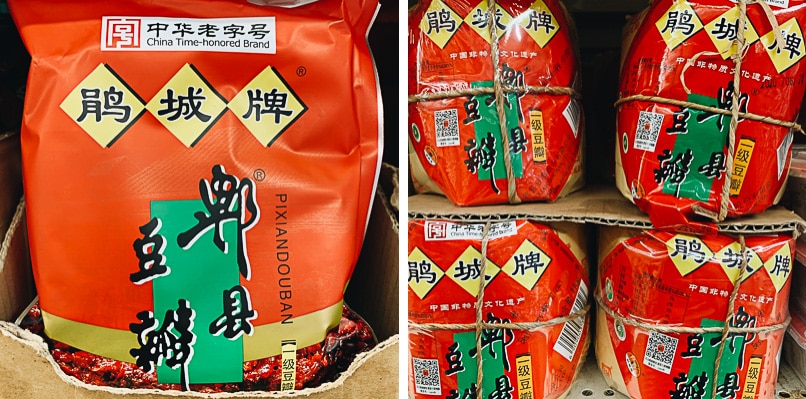
Recommended Brands
Pi Xian Dou Ban (named after its origin and current source of production).
(5) Toasted sesame oil
Toasted sesame oil has a dark amber color and an intense, nutty aroma. It has a low smoking point and can’t stand up to high heat, so it’s usually only used at the end of cooking. I skip sesame oil most of the time in my cooking since I always use a high-quality peanut oil (see above). But it’s an important condiment to have, since you can use it to create delicious soup and dumplings.
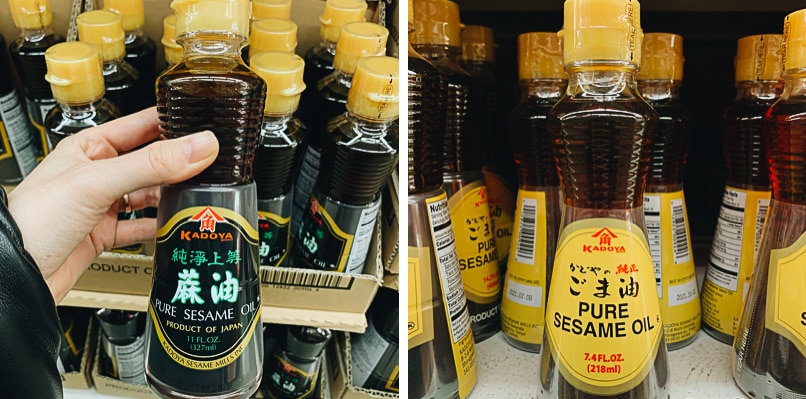
Recommended Brands
Kadoya, Spectrum (can be find in Whole Foods and other grocery stores)
5 Nice-to-have Spices
(1) White pepper powder
White pepper powder (白胡椒粉, Bai Hu Jiao Fen) is widely used in Chinese cooking. It has a sharp, spicy, and smoky flavor that is perfect for adding a clean and light spiciness without being too overwhelming. It is spicier and fruitier, but less complex, than black pepper.
Finely ground white pepper is a key ingredient in popular Chinese dishes such as Hot and Sour Soup and Salt and Pepper Chicken.
(2) Five spice powder
Five spice powder (五香粉, wu xiang fen) is another common ingredient in Chinese cuisine. As its name would suggest, the powder is a mixture of five spices – star anise, clove, cinnamon, fennel seed, and Sichuan peppercorn. Five spice powder has a warm, savory, earthy and licorice flavor. A tiny amount goes a long way. While not a necessity in the Chinese pantry, it is a very convenient spice blend to have, in order to infuse savory goodness into meat dishes.
Five spice powder is usually used in braising, as a dry rub for grilling, and in marinades.
Five spice powder is a key ingredient in the popular Char Siu (Chinese BBQ Pork) and I use it as a secret ingredient in my famous Homemade Chili Oil recipe.
Dried chili pepper
Not only is it a key ingredient in authentic Sichuan food, it’s commonly used in braising and stir-frying to infuse fragrance into the oil. There are a few types of commonly used Chinese chili peppers. For example, Facing Heaven Chili (the most common) is medium-hot and very fragrant. The fat Lantern Chili is smoky and mild. Xiao Mi Chili (looks like a bird’s eye chili) is very spicy.
It’s nice to have dried chilis on hand so you can easily add smokiness and fragrance to your dish.
See how I use dried chili peppers to make this fragrant 4-Ingredient Fried Cabbage and the authentic Sichuan Mala Chicken.
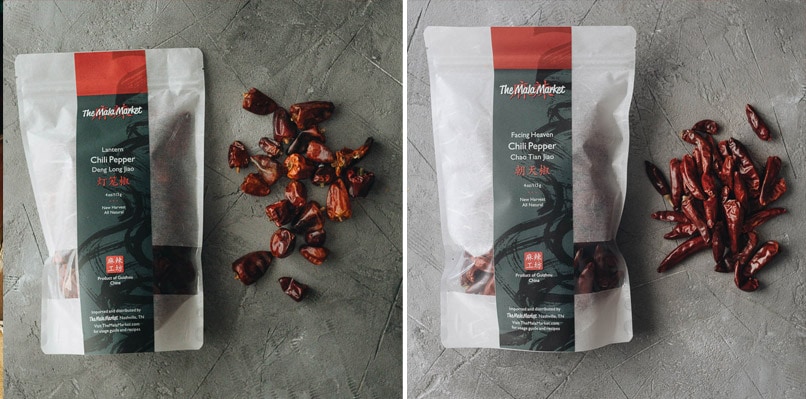
Recommended Brands
The Mala Market (they import premium high-quality ingredients from Sichuan)
Sichuan peppercorn
Sichuan peppercorn, or Hua Jiao (花椒), is a lesser known and underrated ingredient that’s crucial to the Chinese pantry. It has a pungent aroma, slightly lemony overtones, and numbing properties (it’s not exactly “spicy”). If you bite into one of these small peppercorns, you’ll immediately feel the tongue-tingling, buzzing, party-in-your-mouth sensation otherwise known as “ma” (numbing).
It’s a key ingredient in authentic Sichuan food, as important as the chili peppers. And like dried chili peppers, it’s commonly used in stir fries, noodles, and cold dishes, to add an intense aroma to the dish.
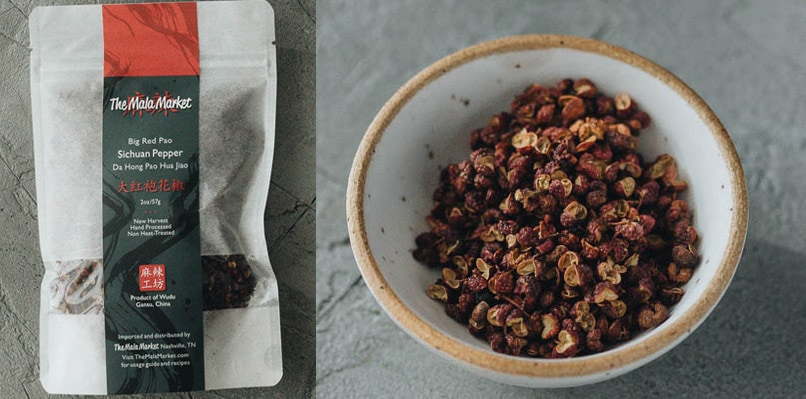
You will need it for all the famous Sichuan dishes, such as Dan Dan Noodles, Mapo Tofu, Kung Pao Chicken, and Dry Fried Green Beans. It’s also a key ingredient to make great Sesame Noodles, Xinjiang Lamb Skewers, and Beef Meat Pies.
Recommended Brands
The Mala Market (some of the most fresh products I’ve seen in the US)
Star anise
One of the ingredients in five spice powder, whole star anise pods (大料, da liao) are commonly used in braised dishes to add a warm licorice-like aroma.
You will need it to make Chinese Red Braised Pork, Tea Eggs, and Soy Sauce Chicken.

Yvonne
Love your recipes, technically helpful videos and commentary.. Having had to replace my beloved gas stove with an induction stove due to modern building codes, your advice re wok substitutes was especially helpful. Also helpful to give recommendations re essential ingredient brands. Thanks!
Alan
New to your site and finding it easy to follow.
Which of your must have ingredients must be kept in the frig.
Maggie
Hi Alan, I’m glad to hear you find my website helpful!
I would always keep oyster sauce, hoisin sauce, Doubanjiang, and fermented black beans in the fridge.
Ksenya Zavarin
hi maggie. love your recipes, and these “cheat sheets” for essential ingredients. i have a question about doubanjiang. i bought a brand readily available at my asian market and i think it’s the one you recommend (red envelope with green rectangle). however, i have a problem – it’s the chili skins, lots of them, and very large pieces. they are as annoying as popcorn skins that get stuck between my teeth, gums, and under my tongue. i’ve been using “as-is” and removing the larger pieces before serving, but wondered whether i should run the paste through a blender. is this how it’s supposed to look, or was my envelope a bad batch? thanks so much!
Marivic Tamura
There is also Wei Wei cold store to find Chinese products esp for hotpot.
Pradeep Singh Chauhan
I want to study more about the chinese cuisine and culture.
Can you suggest any books for it ??
Maggie
I highly recommend All Under Heaven: Recipes from the 35 Cuisines of China by Carolyn Phillips 🙂
Marijke Schellenbach
Great list with very good information on each ingredient!!! Thank you for always sharing your wonderful recipes and helpful hints.
Cheryl Talbot
Thank you Maggie! I just read your list of Asian ingredients. Such a tremendous help to and I’m sure others who love Chinese food and cooking.
Maggie
I’m glad you found this list helpful Cheryl! Let me know if you have other questions about Chinese ingredients or I missed something from the list. I’d like to look into it 🙂
Greg
Very good article. Just bought a wok and want to eat healthier. Thanks!
Maggie
Hi Greg, glad to hear the post is helpful! Happy cooking and enjoy all the delicious stir fry dishes 🙂
Jacqueline
Hi Maggie,
Thanks for all the tips on Chinese ingredients. It is extremely informative.
Your the BEST!
Maggie
You’re the most welcome! Glad to hear the post is helpful 🙂 Have a great day Jacqueline!
Thos
I have never once seen salt-free Shaoxing wine, neither in Asian stores (understandable as they would not be selling alcohol that can be imbibed) or reasonably up-scale liquor stores. Could you tell me what town / city you have to visit to acquire this, and any suggestions you might have for finding / ordering it?
That being said I use the salted stuff presently, and just draw back on any salting suggested in the recipe.
Maggie
Sourcing salt-free Shaoxing wine is one of my biggest issue now. I got mine in 99 Ranch Market in Houston. I’m living in Austin. Our biggest Asian market just started to carry it (the bottle looks a bit suspicious though). Up-scale liquor stores usually don’t carry them. We’ve talked with Spec and seems like they do not have distributor resource to order them.
Yes I think it’s no problem to use the salted one as long as you adjust added salt accordingly. My next best option is dry sherry. The flavor is quite similar to Shaoxing wine, just slightly sweet. I also use rice wine (it’s much easier to get Japanese sake in liquor store) when I cook seafood or poultry, whenever I don’t need a strong flavored cooking wine.
Tom Mone
Hi Maggie,
I have used salt-free wine sourced from this web site. Perhaps you could take a look at their offerings nd see if they are appropriate. appropriate.
https://posharpstore.com/en/search?Cid=&Isc=true&sid=true&sku=true&q=wine
Thank you for all of your very useful information!
Laura B
I’ve bought Shaoxing wine from this site several times and it’s great!
Maggie Zhu
So happy to hear it worked out for you! 🙂
Joseba
Thanks indeed for your tips, recipes and information about oriental cooking.
It´s so clear than push me to try your recipes. They´re easy and I get fantastic results.
Thanks indeed !!
Maggie
Glad to hear the article is helpful and your cooking turns out well 🙂
Zoee Tan
Hi Maggie
Your braised mushroom chicken is superb. My husband loves it. So does my sister. They commented that I am a good cook but I believe it’s your recipe :-).
I have just downloaded some of your other recipes to try.
Thank you very much for sharing.
Maggie
Hi Zoee, thanks so much for leaving a comment and letting me know your cooking result! And I’m so glad to hear you enjoyed it 🙂 You just made my day!
Happy cooking and have an awesome weekend!
ColinR
Thanks for this article maggie; it’s just what I needed. Deciding to learn chinese cookery is a bit like deciding to learn European cookery; there’s a lot of it; it can be overwhelming. What attracted me to chinese cooking is that it respects the main ingredients. Gradually learning how these basic flavourings are used to compliment different meats and veg offers plenty to engage with.
Maggie
Hi Colin, I’m so glad you found this list helpful. Yes, if you’re just starting out, the new ingredients and spices might sound a bit daunting. However, I found there are many ways to incorporate the cooking with a lot of cookware and ingredients you already have. Of course you’ll come across more than the ones listed here, but with the top 10, you already can cook most of the dishes from my ebook (it’s for free when you sign up my newsletter) 🙂 Seems like you already get the gist of Chinese cooking very well 😉
Have a wonderful week ahead!
Tony
Hey Maggie was looking through your comments and saw Kevin in 2016 mention the ginger paste.i know it’s a few year later 😂 I make my own ginger paste and garlic paste for my italian Asian and middle Eastern cooking the cost can be high throughout the year, I grow my own garlic and ginger At my apartment in large tubs by the window when it’s ready to harvest I blend all the garlic in normal blender with cooking oil(rapeseed and little peanut oil) and do the same with the ginger and I then put the pastes in large chip shop pickle jars usually fill one with the ginger paste the garlic is around half to three quarters and both are very strong in flavour they last whole year in fridge the oil preserves them and doesn’t affect the flavour if I have a busy cooking year I top up with some store bought if I don’t have any ready for picking so it never runs out and very rarely have to buy any to top up maybe once or twice the past few years I recommend everyone do this takes no effort not much space just soak and plant some ginger root plant a few sections of garlic wait couple month harvest repeat always have a fresh batch every couple month depending on your indoor growing skills and indoor climate control👍
Kevin | Keviniscooking
Fantastic write up here Maggie and I am happy to report I have everything either in my pantry or refrigerator except for the Doubanjiang. While I do have fermented black bean paste, it’s not the red spiced one you have here. One thing though – no ginger paste? I use that non stop! If I don’t have any of the fresh ground ginger paste I always keep a frozen root in the freezer and grate it. 🙂
Maggie
Wow, it’s surprising to hear you got everything for cooking Chinese food Kevin! Sounds great 🙂
As for the ginger, I personally always prefer the fresh ginger root. I grate them in food processor and freeze them, if I got more than I can use. But since we can easily get it at most supermarket, and I use quite a lot, I just cut the portion I need from the root. How long will the fresh ginger paste stay good in the fridge? I want to try this too so I can save prep time!
Kevin | Keviniscooking
I usually pick it up in any Asian market and now in most food markets in the vegetable section. It’s in jars or tubes. Ginger paste lasts a bit, but I usually buy the smaller jars and use it quick. Fresh is the best!
Maggie
I’ll look out for these next time. Fresh is the best, but the paste sounds so convenient when I’m in a rush. Thanks for sharing the tips Kevin 🙂
Amita Bhalla
I normally grind a big bunch of ginger as I use it a lot(I am Indian) what I do is after grinding I put it in ice tray to freeze. Then remove the cubes and store them in freezer bags in the freezer. This way I use one cube at a time without having to thaw the whole lot.BTW I do the same for Thai green curry paste.
Alice
I have everything except the doubanjiang and the peanut oil, so I guess I’m on the right track! Love your blog- you make everything sound easy and delicious! Oh, and I just keep ginger root at room temp in a little bowl along with my fresh garlic. It stays fresh a long time, at least 2 weeks, without going rotten or moldy, without water or refrigeration. It gets dried out eventually, but I try to use it before then.
Maggie
Hi Alice, yep, it seems like you’re on the right track! I’m so glad to hear you like my blog 🙂
Thanks for sharing your tip of storing ginger! My mom used to keep them in room temperature without any problem. Next time I’ll try keep them in the room temperature with some damp paper towel wrapped around. The wet paper won’t cause rotten because it’s allow the air to flow (I discovered it by a “flood” accident). But yeah, they will eventually dry out. If I cannot use it fast enough, I’ll just freeze it.
Amita Bhalla
Even if ginger dries out, it’s aroma intensifies. BTW I love your recipes. So good and easy to make
Robyn @ Simply Fresh Dinners
I’m so excited to have this list, Maggie. I really want to explore Chinese cooking and your beautiful dishes are such an inspiration. I’m going to have fun scouting out these ingredients, too. Great post!
Maggie
You probably only need one trip to the Asian market to get all of them. If you’re just starting out, the first ten ingredients are enough for you to cook many dishes. Like, most the recipes in my ebook 😉
J-Mom
This is a great resource. I had to immediately check my soy sauce ingredients. And next time I’m getting the ‘toasted’ sesame oil.
I do have black bean sauce. Do I also need the fermented black beans?
Ginger: I use them up to twice a week. So I end up peeling them, cutting them into tablespoon size and freezing them, grate them frozen as needed. Is there a better way to store them?
Maggie
Nope, you don’t need the fermented black beans if you already have the sauce. I actually like the sauce more, because the flavor is more balanced. I listed the black beans here, because you can use them to make the sauce in a slightly cheaper way. They also stay in your fridge slightly longer.
As for the ginger, what I usually do is to freeze a portion of the root after purchasing, if the chunk is too big. I grate them in food processor, flatten them in a bag and freeze them. So I can break off a piece whenever I need it. For the fresh ginger root, I wrap them with several layers of paper towel and wet the towel with water. You need to wet the towel every few days, but the ginger root will stay fresh for very long time. Don’t put it into a bag. So ginger can breath and won’t rot.
I hope this is helpful!
David
Maggie,
I keep my ginger root in a rolled up brown paper bag in the refrigerator and it keeps far longer than out on the counter.
Really enjoy your recipes, keep them coming
Lynn
I have two ways of storing ginger. If I’m going to be using it within a week or so, I wrap it in alfoil and store in the crisper section of my fridge. For longer, I peel it and store in 1 inch chunks in sake in the fridge. I guess shao xing wine would work just as well.
Nancy | Plus Ate Six
Fantastic round up! I’ve seen the lily flowers but had no idea what they are or what to do with them. And now I do 🙂
Maggie
Hi Nancy, you need to try out the lily flowers while you can get the good ones in China (I need to bring these to the US every time, because the local ones are not very fresh)! They taste great in stew and stir-fry. If it’s your first time to cook with them, try to add a few into a savory stew, like braised chicken (something like this: https://omnivorescookbook.com/recipes/moms-best-braised-chicken-with-mushrooms). I believe you’ll like the taste 🙂
Helen @ Scrummy Lane
I learn so much from you about Chinese cooking, Maggie – I love how you make it all so easy to understand.
I love Chinese 5-spice powder – it makes such a huge difference to the flavour of a dish. And I just bought some Siaoxing wine to try in a receipe – it was great!
Maggie
I love five spice powder too! It’s really powerful and a tiny amount makes a dish very different. I’m glad you decided to try out Shaoxing wine and able to find it! Looking forward to reading your new recipe 🙂 Have a great weekend!
Marissa | Pinch and Swirl
What a great reference, Maggie! Thank you so much…